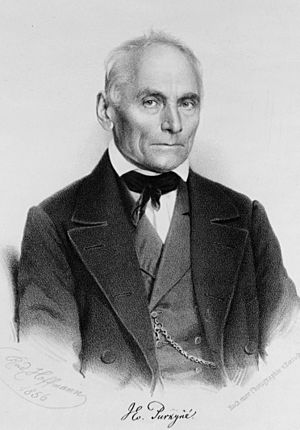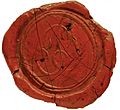Jan Evangelista Purkyně facts for kids
Quick facts for kids
Jan Evangelista Purkyně
|
|
|---|---|

Purkyně in 1856
|
|
| Born | 18 December 1787 Libochovice, Bohemia, Austrian Monarchy
|
| Died | 28 July 1869 (aged 81) |
| Nationality | Czech |
| Alma mater | University of Prague |
| Known for | Purkinje cells Purkinje effect Purkinje images Purkinje fibres |
| Scientific career | |
| Fields | Anatomy, physiology |
| Institutions | University of Breslau |
Jan Evangelista Purkyně (born December 17 or 18, 1787 – died July 28, 1869) was an important Czech anatomist and physiologist. He was famous for his discoveries about the human body and cells. In 1839, he created the word "protoplasma" for the jelly-like substance inside cells. He was so well-known that people sending letters to him from outside Europe only needed to write "Purkyně, Europe" as the address!
Contents
Early Life and Education
Jan Evangelista Purkyně was born in a region called Kingdom of Bohemia. This area is now part of the Czech Republic. In 1804, after finishing high school, Purkyně joined a religious group called the Piarists. He became a monk for a short time. However, he soon left the order. He wanted to be free to study science more deeply.
In 1818, Purkyně earned his medical degree. He studied at Charles University in Prague. Later, he became a Professor of Physiology there.
Amazing Discoveries About the Body
Purkyně made many important discoveries about how our bodies work. He studied how our senses, like sight, function.
How We See in Different Light
One of his discoveries was the Purkinje effect. This explains why our eyes see dim red light less brightly than dim blue light. This happens especially when it's getting dark. He wrote about this and other eye phenomena in 1823. His work helped create the science of experimental psychology. This field studies how our minds and senses work.
Setting Up Science Labs
Purkyně was a pioneer in setting up special science labs. In 1839, he created the world's first Department of Physiology. This was at the University of Breslau in Prussia (now Wrocław, Poland). Just a few years later, in 1842, he opened the world's second official physiology laboratory. These labs were crucial for studying the human body.
Discoveries Inside the Body
Purkyně is famous for finding special parts of our bodies.
- In 1837, he discovered Purkinje cells. These are large nerve cells with many branches. You can find them in the cerebellum, which is part of your brain.
- In 1839, he found Purkinje fibres. These are tiny fibers in the heart. They help carry electrical signals that make your heart beat.
- He also studied Purkinje images. These are reflections of objects that you can see inside your own eye.
- Purkyně also introduced important scientific terms. He used "plasma" for the liquid part of blood. He also used "protoplasm" for the living material inside cells.
New Ways to Study Cells
Purkyně was innovative in how he studied tiny parts of the body.
- He was the first to use a microtome. This tool makes very thin slices of tissue. These thin slices can then be looked at under a compound microscope.
- He was also one of the first to use an improved version of the compound microscope. This allowed scientists to see much more detail.
- In 1833, he discovered sweat glands in the skin.
- In 1823, he published a paper about fingerprints. He identified 9 main patterns of fingerprints. This was a very early step in the science of forensics!
- In 1838, he was the first to describe a pigment called neuromelanin. This pigment is found in a part of the brain called the substantia nigra.
Early Moving Pictures
Purkyně was also interested in how we see movement. He understood the importance of Eadweard Muybridge's work with photography. Purkyně even built his own version of a stroboscope. He called it a forolyt. He would put nine photos of himself on a spinning disc. He entertained his grandchildren by showing them how he, an old professor, seemed to spin around very fast!
Family Life
In 1827, when he was 40, Purkyně married Julia Agnes Rudolphi. She was the daughter of a scientist who supported his work. They had two daughters and two sons. Sadly, his wife and daughters died from a disease called cholera. His two sons survived. His older son, Emanuel, became a naturalist. His younger son, Karel, became a painter.
Jan Evangelista Purkyně passed away in 1869. He is buried in the Vyšehrad National Cemetery in Prague, Czech Republic.
Lasting Legacy
Purkyně's work left a big mark on science and his home country.
- A university in Brno, Czech Republic, was named after him from 1960 to 1990.
- Today, the Jan Evangelista Purkyně University in Ústí nad Labem still carries his name.
- Even in space, his name lives on! A crater on the Moon, called Purkyně, is named after him.
- An asteroid in space, 3701 Purkyně, also bears his name.
See also
 In Spanish: Jan Evangelista Purkyně para niños
In Spanish: Jan Evangelista Purkyně para niños
- List of Czech scientists
Images for kids



